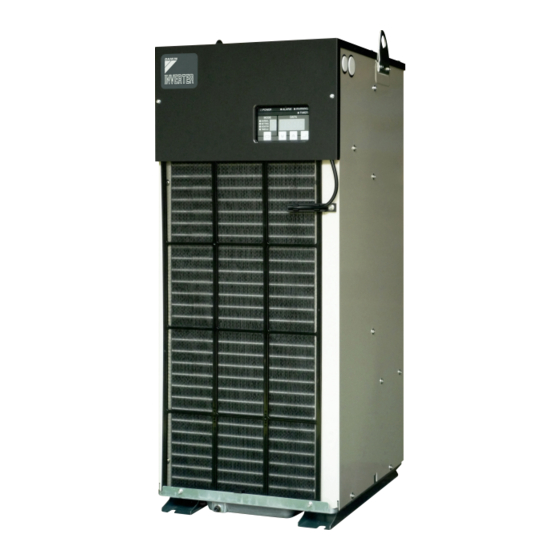
Table of Contents
Advertisement
PIM00318A_EN.fm Page -1 Tuesday, October 26, 2010 12:37 PM
DAIKIN Oil Cooling Unit
("OILCON")
AKZ9 Series
Models
Menu
Built-in
Standard
breaker
model
model (-B)
Series
AKZ149
AKZ329
AKZ439
Thank you for purchasing DAIKIN Oil Cooling Unit ("OILCON").
This instruction manual includes instructions for using the Oil
Cooling Unit.
To ensure proper use of this product, be sure to read through this
instruction manual before using it.
After reading this manual, keep it handy for your future reference.
Proper use results in power saving
If the air filter is clogged, the cooling performance deteriorates,
causing excess power consumption.
Clean the air filter periodically to reduce power consumption.
Instruction Manual
Circulating type
Compliant with
ROHS
Built-in heater
Built-in tank
model
model
Built-in breaker
model
CE model
Built-in
CE model
Different-
heater
(-C)
voltage
model (-H)
Installation
Handling
Different-voltage
model
Built-in
tank model
(-T)
Maintenance
although no alarm is activated
• When a warning is generated
CE compliance declaration
PIM00318A
CONTENTS
1
4
5
6
7
8
13
14
15
16
18
19
20
21
22
23
24
25
27
30
33
33
34
35
36
37
38
42
Advertisement
Table of Contents

Summarization of Contents
Safety Precautions
General Safety Warnings
DANGER, WARNING, CAUTION categories and essential safety rules.
Installation Safety
Guidelines for safe installation, wiring, and handling during installation.
Operational Safety Hazards
Electrical hazards, heat, and cut risks during operation and maintenance.
Installation Procedures
Transportation and Storage
Guidelines for safe transport, handling, and storage of the unit.
Installation Site and Piping
Criteria for selecting installation location and oil piping requirements.
Pipe Selection Guide
Information and charts for selecting appropriate pipe sizes and lengths.
Electric Wiring and Connections
General guidelines and procedures for electrical connections.
Wiring Procedures
Detailed steps for mounting circuit breakers and connecting wiring.
Control and Output Connections
Information on remote control, external output, and wiring diagrams.
Model Identification and Specifications
Model Identification
Explains symbols for series, menu, and distinction for model identification.
Technical Specifications
Details cooling capacity, power, dimensions, and other technical data.
Before Operation Procedures
Operating Environment Checks
Verifies atmosphere, operating range, and environmental factors before use.
Pre-Operation Installation Checks
Confirms secure fastening, clear air paths, oil piping, and applicable oil type.
Electric Wiring Checks
Verifies cable size, grounding, and power supply for safe operation.
Operation for Pump-less Models
Guidance for customers using models without a built-in pump.
Part Names and Functions
Component Identification
Identifies and describes the function of all major unit components.
Control Panel Interface
Control Panel Overview
Names and describes the function of each control panel button and indicator.
Operation Mode Selection
Explains the seven operation modes and how to change between them.
Operation Setting Procedures
Holding Constant Oil Temperature
Guides setting operation modes 0 and 1 for stable oil temperature control.
Tuning Oil Temperature
Explains setting modes 3-6 for temperature control based on room or machine temperature.
Cooling Oil at Constant Capacity
Details setting mode 9 for cooling based on a capacity command percentage.
Useful Functions
Monitor Items
Lists items that can be checked in Monitor mode, with their corresponding numbers.
Timer Operation
Explains how to use the ON timer for starting the unit after a set delay.
Additional Setting Functions Overview
Introduces functions like Auto-tuning, Temperature range warning, and communication.
Parameter List
Table of parameters for additional setting functions, including items and ranges.
Temperature Range Warning Setup
Details setting up temperature range warnings and their application scenarios.
Parameter Setting Procedure
Step-by-step guide to setting parameters on the control panel.
Auto-tuning Mode
Explains how to use auto-tuning to improve temperature control performance.
Optional Parts
Machine Temperature Tuning Control
Describes thermistors for detecting machine temperature and their installation.
Returned Oil Temperature Control
Details thermistors for detecting returned oil temperature and their installation.
Communication with Main Machine
Explains the optional communication board for data exchange with the main machine.
Maintenance and Inspection
Daily Maintenance Inspections
Routine checks for oil level, cleanliness, and wiring integrity.
Periodic Maintenance Inspections
Scheduled tasks like cleaning strainers, air filters, and condensers.
Unit Storage
Guidelines for leaving the unit unused for extended periods.
Troubleshooting
Operation Abnormalities Without Alarm
Lists common issues and their causes/corrective actions when no alarm is active.
Alarm List
Comprehensive list of alarm codes, descriptions, causes, and corrective actions.
Warning List
Comprehensive list of warning codes, descriptions, causes, and corrective actions.
CE Compliance Declaration
Declaration of Conformity
Official statement regarding compliance with European directives and harmonized standards.
















Need help?
Do you have a question about the AKZ439 and is the answer not in the manual?
Questions and answers